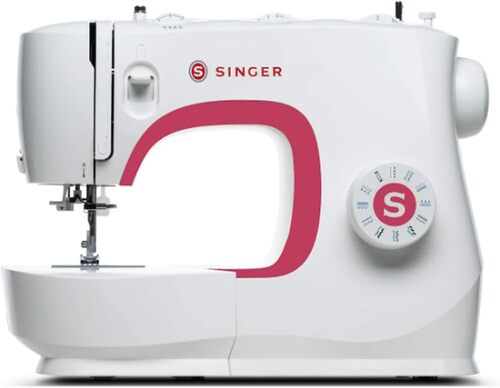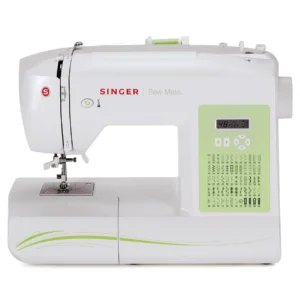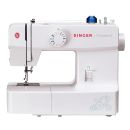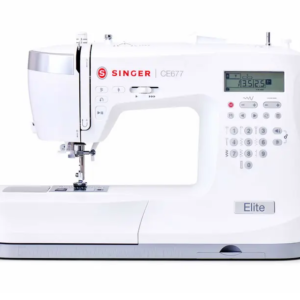
The Box on My Doorstep
I still remember the morning the little white-and-red box landed on my doorstep. I’d been scrolling through Singer MX231 reviews for weeks, trying to figure out if this small, portable machine could handle my messy list of projects: hemming jeans, fixing a ripped cushion, maybe even a knit T-shirt if I got brave. My old hand-me-down had finally coughed its last stitch, so it was time to start fresh with the SINGER MX231 Sewing Machine.
Unboxing & First Impressions
Unboxing felt like opening a toolbox I actually wanted to use. The machine looked clean and compact, easy to lift with one hand. I liked the simple dials — no screens, no beeping menus — just the basics. There’s an LED that lights up the work area, and the free arm slides off so you can sew cuffs and small tubes. The whole thing feels friendly, like it’s saying, “Relax, we’ve got this.”
The Manual Plot Twist (Where’s the Book?)
Then I met my first plot twist: the manual. Or, more accurately, the lack of one. Inside the box was a quick-start sheet with pictures, but the full guide lives online. I printed it later, but that first hour I was squinting at drawings and guessing. If you’re brand-new, know this: the bobbin loads in the front (vertical). You open the little door, pop the case out, and it clicks back in when you return it. It’s fussy the first time, but once you understand which way the thread needs to unwind, it’s fine. (If your stitches tangle, rethread top and bobbin slowly — nine times out of ten, that fixes it.)
Threading, Needle-Threader & First Stitches
Threading the top path went quickly because the machine has the guide numbers printed right on the body. The built-in needle threader is… occasionally moody. On good days it pops the thread through like a magic trick; on stubborn days I just thread it by hand and move on. Either way, it didn’t slow me down much.
My first project was the lowest of low-stakes: hemming pajama pants. I chose a simple straight stitch, pressed the foot down, took a breath, and tapped the pedal. The motor purred — not silent, but not scary — and the feed dogs grabbed the fabric evenly. When I finished the seam, I looked down and smiled: neat, even stitches. Confidence boosted.
Cracking the “Blue Stitches” Code (Hello, S1)
Next, I tried a cotton tote bag. This is where I discovered the “blue stitches” on the dial. If you’re reading this mini Singer MX231 review and you’re confused by those, here’s the trick: turn the stitch length knob past “0” to S1 to access them. Once I figured that out, the world opened up — stretch stitches, lightning bolt zigzags, and a few decorative bits for fun. The machine advertises 97 stitch applications; I won’t use all of them, but it felt like having a big box of crayons waiting for my next idea.
Stretch Test: Sewing Knits Without Tears
I cut up an old jersey tee to make a quick headband. I switched to a ballpoint needle, used a stretch stitch in S1 mode, and let the machine crawl while I kept the fabric relaxed. It didn’t chew or tunnel the knit, which was a happy surprise. If you’re planning a lot of knitwear, the Singer MX231 can do it — just pair it with the right needle and don’t floor the pedal.
Little Hiccups I Met Along the Way
- On day two, I got the dreaded bird’s nest underneath the fabric. I discovered I’d threaded the bobbin case incorrectly in my rush. Rethreaded everything (presser foot up while threading the top, always), cleaned out a dust bunny I’d already collected, and it was smooth again.
- The reverse button works, but you have to hold it while sewing backward. That means one hand guiding fabric instead of two. Not a deal-breaker, just a quirk.
- On very thin fabric right at the edge, the needle tried to push the fabric into the plate during backstitching. My fix: start ¼” from the edge, use a scrap leader, or switch to a smaller needle.
- The machine is lightweight (hello, portability), which also means it can hop a little on thick seams. A nonslip mat under the base calmed that dance instantly.
- I couldn’t find a presser-foot pressure adjustment. For most tasks it didn’t matter, but it’s worth noting if you like to fine-tune everything.
The Denim Hem Challenge
Time for the real-world test: hemming jeans. I swapped in a size 90/14 needle, lengthened the stitch, and stitched slowly over the bulky side seams. The SINGER MX231 Sewing Machine didn’t stall; I just helped it over the “jean mountain” with the hand wheel for a stitch or two. Clean result, zero tailor fees.
Creative Afternoon Sprint
The best afternoon with the machine was a little creativity sprint. I sewed a soft baby bib, added a row of decorative stitches along the edge (because why not), and topstitched a canvas cushion cover. The LED kept the area bright, the foot pedal gave me good control, and the machine never felt intimidating. I get why so many Singer MX231 reviews call it beginner-friendly: the learning curve is real, but short — especially once you decode the stitch dial and bobbin case.
Small Habits, Big Results (Quick Tips)
- Change needles with the project: universal 80/12 for most cottons, ballpoint for knits, 90/14 for denim.
- Slow and steady at bulky seams; let the feed dogs work.
- Rethread anytime stitches look weird. Presser foot up while threading, and make sure the bobbin spins the correct direction in the case.
- Keep a tiny brush nearby. A clean bobbin area saves headaches.
- If the fabric wants to dive into the plate, start on a scrap leader, or move in from the edge and hand-wheel the first stitch.
Final Verdict: Is the Singer MX231 for You?
Two months in, I’ve mended uniforms, shortened curtains, patched a quilt, and made that knit headband I now wear on laundry day. The machine lives on a shelf because it’s light, and I just carry it to the table when I’m ready to sew. It’s not a luxury model with a hundred bells and whistles—no screen, no auto cutter — but that’s part of why I actually use it. It’s approachable.
If you came here searching for a friendly, real-world Singer MX231 review, here’s my honest take: the Singer MX231 is a solid, portable little workhorse for everyday sewing, hemming, light quilting, and simple knit projects. Be prepared to print the manual and spend an hour learning the bobbin and “S1” stitches. After that, it’s mostly you, your fabric, and a steady hum.
The SINGER MX231 Sewing Machine made me enjoy sewing again. It’s simple, portable, forgiving, and capable for everyday tasks. If you’re comparing Singer MX231 reviews, add mine to the “happy and still sewing” pile.
Singer MX231 Review — Pros & Cons from Real Customers
| Pros (What customers like) | Cons (What customers complain about) |
|---|---|
| Beginner-friendly for basics: many first-time/returning sewists say they could hem, mend, and tackle small projects quickly. | Poor/absent manual: full instructions are online only; quick-start sheet is confusing and not model-specific, making setup tough for beginners. |
| Lightweight & portable: easy to carry/store; good for small spaces or as a second machine. | Front-loading (vertical) bobbin frustrations: hard to insert, easy to mis-thread, can fall out, and you can’t see remaining thread; frequent reports of nests/jams underneath. |
| Good value/price: viewed as affordable for everyday mending and craft use. | Jamming/tension issues: several users report bird’s nests, touchy tension, or timing problems (needle hitting plate); quality control varies. |
| Easy top threading & numbered guides: most find threading the upper path straightforward. | Needle threader is hit-or-miss: some units arrive with it broken or it works inconsistently. |
| 97 stitch applications (incl. stretch) once you learn the S1 setting; fun for light decorative work. | Learning curve for “blue stitches”: switching to S1 (past “0” on length dial) isn’t explained clearly. |
| Handles common fabrics: successful hems on jeans, canvas/cotton; some even report vinyl upholstery with proper needles. | Not heavy-duty: too light for thick layers; may vibrate/hop or struggle at bulky seams without careful technique/needle choice. |
| Free arm & LED light: helpful for cuffs/sleeves and visibility. | Reverse button & controls quirks: must hold reverse; some dislike pedal/cord orientation and limited fine control at very slow speeds. |
| Quiet enough for many users and feels steady on the table (for light work). | No/unclear buttonhole instructions and occasional reports of zigzag/secondary stitches not working on some units. |
| Attractive, compact design: often gifted to teens/grandparents and well-received. | Customer service/returns pain points: long hold times reported; some units arrive missing parts or with shipping damage; noise/vibration complaints from a minority. |
| Saves tailoring costs: hemming/alterations at home pay off quickly. | Spare parts & accessories confusion: e.g., extra spool pin info hard to find. |
Singer MX231 Sewing Machine – Frequently Asked Questions
What is the Singer MX231 and who is it for?
The Singer MX231 is a lightweight, portable mechanical sewing machine designed for everyday mending, simple crafts, and beginner projects. It has easy dials, an LED light, a free arm with a removable extension table, and stretch-capable stitches (S1/S2). If you’re scanning Singer MX231 reviews for a first machine, this model aims to be simple, reliable, and approachable for home use.
How do I wind and insert the bobbin on the SINGER MX231 Sewing Machine?
Place the thread on the spool pin, route it through the bobbin winder path, push the bobbin spindle to the right, run a few turns, trim, then wind fully. For insertion, raise the needle, open the front cover, hold the bobbin case, insert the bobbin so the thread turns clockwise, pull the thread through the slit and under the tension finger, then click the case into the shuttle.
Which bobbins does the Singer MX231 use?
Use SINGER Class 15 bobbins (the machine typically includes four). Using the correct class helps prevent tension issues and jams noted in many Singer MX231 reviews.
How do I thread the upper thread and use the needle threader?
Raise the presser foot, turn the handwheel so the take-up lever is at the top, follow the numbered guides down-right and up-left into the take-up lever, then down to the needle (front to back). For the automatic needle threader: raise needle, pass thread around the guide, press the lever fully, hook the thread under the tiny hook, and release to pull the loop through.
How do I bring up the bobbin thread?
Hold the top thread with one hand and turn the handwheel toward you; the needle dips and brings the bobbin loop up through the needle plate. Pull both threads under the presser foot toward the back before sewing.
How do I select stitches, including the blue stretch stitches (S1/S2)?
Turn the Pattern Selector Dial to the pattern you want. For straight or zigzag, just choose the icon. For the blue stretch/decorative options, turn the Stitch Length Dial to S1 or S2, then pick the desired pattern—this is how many owners unlock the extra stitches mentioned in their Singer MX231 review.
What do the tension and length/width dials do on the Singer MX231?
A good starting point for upper tension is 4 (most sewing happens between 3–5). Use less tension for zigzag/decorative stitches. Stitch Length controls how long each stitch is; Zigzag Width (0–5) sets how wide the zigzag is and also shifts straight-stitch needle position (0 is center; moving toward 5 shifts fully left or right depending on model).
Does the SINGER MX231 Sewing Machine have 1-step or 4-step buttonholes?
The manual covers both systems. If your machine has a buttonhole lever beside the needle bar, you have a 1-step buttonhole; if not, you’ll use the 4-step process via the dial sequence. Either way, mark the hole, attach the buttonhole foot, test on scrap, and follow the steps shown in the manual.
How do I sew a blind hem on the Singer MX231?
Press the hem, fold it as shown in the guide, select the blind hem stitch appropriate for stretch or firm fabrics, use a longer length, and set width to just catch a thread of the fold. A blind hem foot makes it even easier (optional accessory).
Can the Singer MX231 handle denim or multiple layers?
Yes for everyday hems and light denim work: use the Two-Step Presser Foot Lifter to raise the foot higher, slow down at bulky seams, and fit the right needle (90/14 for denim; heavier fabrics may need size 16/100). For very thick stacks, go slowly and hand-wheel as needed.
How do I reverse stitch and cut threads?
Hold the Reverse Lever while you sew backward to lock seams, then release to go forward. When you finish, raise the take-up lever, lift the foot, pull fabric back, and slide the threads into the built-in cutter at the side to trim.
What accessories come with the SINGER MX231?
Typical pack: all-purpose foot, zipper foot, buttonhole foot (type depends on model), button-sew-on foot, seam ripper/brush, L-screwdriver, needles, 4x Class 15 bobbins, edge/quilting guide, darning plate, spool holder, and a soft cover—plus the removable extension table that doubles as storage.
Is presser foot pressure adjustable on the Singer MX231?
There’s no user-listed presser-foot pressure adjustment in the MX231 manual. For thicker layers, use the Two-Step Presser Foot Lifter for extra clearance, choose the correct needle and stitch length, and feed the fabric without pulling.
What needles and threads should I use?
Match needle size to fabric: 70/9–80/11 for light cottons and voile; 80/12–90/14 for medium cottons and denims; 100/16 for heavier canvas/upholstery; leather/vinyl use SINGER 2032; knits use SINGER 2045 (ballpoint). Use similar quality thread top and bobbin for best results.
How do I maintain and oil the SINGER MX231 Sewing Machine?
Unplug first. Remove the needle plate and brush out lint from the feed dogs and hook area. Pop off the hook race cover as shown, wipe clean, and add 1–2 drops of sewing machine oil at the indicated point before reassembling. Regular cleaning prevents the bird’s nests and noise many Singer MX231 reviews mention.
What safety and electrical tips should I know?
Never leave the machine plugged in unattended; always unplug before cleaning or changing needles/feet. The unit is double-insulated (no ground), use only identical replacement parts, and if the LED lamp is damaged it must be replaced by qualified service. Use the specified foot control type only, as listed in the manual.
How loud is the Singer MX231?
Under normal operation the noise level is less than 75 dB(A), which is typical conversational range for home sewing.
How do I use the free arm and accessory storage?
Slide off the removable extension table to access the free arm for cuffs and small tubes; the inside of that table doubles as an accessory box to store feet, bobbins, and tools.
What should I check if my stitches are loose, skipping, or the machine jams?
Re-thread the top path with the presser foot UP, confirm bobbin is clockwise in the case and threaded under the finger, set tension around 4, fit a fresh needle for your fabric, and clean lint from the hook/feed dogs. Don’t pull fabric while sewing; let the feed dogs move it. These steps solve most issues quickly.
Where can I find a quick Singer MX231 review take-away?
In short: the Singer MX231 is a practical starter machine—portable, simple dials, free arm, stretch-capable stitches (S1/S2), and easy maintenance. Learn the bobbin and threading once and you’ll handle everyday hems, mending, and crafts confidently. For more details, check the official manual sections on threading, tension, stitches, and care.
| Category | Specification |
|---|---|
| Model | SINGER MX231 (household, mechanical) |
| Standards & Design | Double-insulated household machine; designed to comply with IEC/EN 60335-2-28 and UL1594 |
| Noise Level | < 75 dB(A) under normal operation |
| Power & Control | On/Off power & light switch; electronic foot control pedal regulates speed |
| Supported Foot Controls (by region) | 110–127V: KD-1902/FC-1902, 4C-316B/4C-316C • 220–240V: KD-2902/FC-2902A/-2902C/-2902D, 4C-326C/4C-326G/4C-336G |
| Lighting | Integrated LED work light |
| Bobbin System | Front/vertical bobbin with removable bobbin case; uses SINGER Class 15 bobbins |
| Bobbin Winding | Top bobbin-winder with spindle; machine disengages when spindle pushed right |
| Max Zigzag Width | 5 mm (adjustable 0–5 via Stitch Width Dial) |
| Stitch Length Range | Approx. 0–4 (shorter numbers = shorter stitches) |
| Needle Position | Adjustable with Stitch Width Dial for straight stitch (center to full left/right depending on model family) |
| Stretch/Decor Stitches | Access via S1/S2 on Stitch Length Dial; blue icons on selector dial |
| Buttonhole | Machine family covers 1-step or 4-step systems; follow the procedure shown for your MX231 variant |
| Reverse | Manual reverse lever (hold to back-tack) |
| Threading Aids | Automatic needle threader; built-in thread cutter |
| Free Arm | Yes — remove the extension table to access cuffs/sleeves |
| Presser Foot Lift | Two-Step Presser Foot Lifter for extra clearance on thick layers |
| Feed Control | Standard feed dogs; darning plate included for free-motion/darning (covers feed) |
| Recommended Tension | Upper thread baseline around “4”; most sewing between “3–5” |
| Needle Types/Sizes | SINGER 2020 (sharp), 2045 (ballpoint), 2032 (leather); sizes ~70/9 to 110/18 (match needle to fabric/thread) |
| Included Accessories | All-purpose foot, zipper foot, buttonhole foot (type per model), button-sew-on foot, seam ripper/brush, L-screwdriver, needle pack, 4× Class 15 bobbins, edge/quilting guide, darning plate, spool holder, soft cover, removable extension table with accessory storage |
| Maintenance | Front access hook; clean feed dogs/hook area regularly; lubricate hook race with 1–2 drops of sewing-machine oil as indicated |
| Safety Notes | Unplug before maintenance; LED lamp and damaged cords must be serviced by qualified personnel; do not operate with blocked vents |




